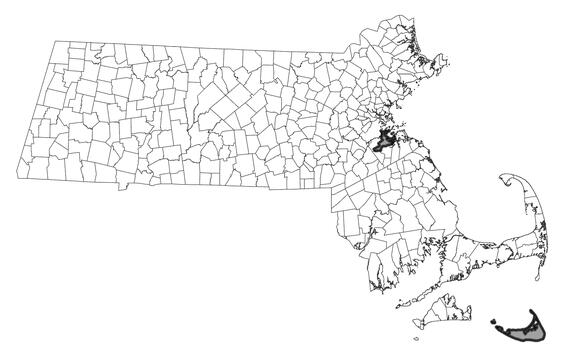- Scientific name: Ageratina aromatica L.
- Species of Greatest Conservation Need (MA State Wildlife Action Plan)
- Endangered (MA Endangered Species Act)
Description
Lesser snakeroot. Photo credit: Robert Wernerehl
Lesser snakeroot (Ageratina aromatica) is a perennial herb of dry woodlands and barrens. It is a member of the composite family (Asteraceae) and has opposite leaves and white flowers that bloom from August to mid-September.
Lesser snakeroot can grow to 80 cm (2.75 ft) in height, but in Massachusetts it is typically less than 60 cm (2 ft). The stem is hairless (glabrous) or nearly so and may be either simple or with a few branches in the upper portion. The thick, leathery opposite leaves of lesser snakeroot are 3-10 cm (1-5 in) long and 2-5.5 cm (0.75-2 in) wide, with short, but distinct stalks. The leaf margins have teeth that are rounded to acute at the apex. The inflorescence is a corymb (flat-topped open flower cluster) of discoid heads made up of small, bright white flowers. The leafy bracts below the heads (involucral bracts) are mostly even, in one series and do not overlap.
Life cycle and behavior

Lesser snakeroot resembles the more common white snakeroot (Ageratina altissima), but has much shorter leaf stalks, and leaf tips that are blunt to short-pointed, compared to the long-tapering tips of white snakeroot. Other similar species in Massachusetts include bonesets (Eupatorium spp.), which generally have involucral bracts that are uneven and overlap, and duller white flowers due to dense bristles concealing each floret.
Population status
Lesser snakeroot is listed under the Massachusetts Endangered Species Act as Endangered. All listed species are legally protected from killing, collection, possession, or sale, and from activities that would destroy habitat and thus directly or indirectly cause mortality or disrupt critical behaviors. Lesser snakeroot is currently known from Middlesex, Norfolk, and Nantucket counties, and is historically known from Barnstable, Bristol, Dukes, Plymouth, and Suffolk counties. The MassWildlife’s Natural Heritage & Endangered Species Program (NHESP) database has 16 records from 5 counties: Dukes, Middlesex, Nantucket, Norfolk, and Suffolk. Only 2 of these records have been observed within the last 25 years.

Distribution in Massachusetts
1999-2024
Based on records in the Natural Heritage Database
Distribution and abundance
The range of lesser snakeroot extends from Massachusetts and New York to southern Ohio, south to Florida and Louisiana. It is also rare in Connecticut, New York, Ohio, Pennsylvania, and West Virginia, and its status is under review in several states. It is historically known from Delaware and Rhode Island.
Habitat
In Massachusetts, lesser snakeroot inhabits dry, open habitats of rocky slopes and sandy barrens, particularly in locations that have a recent history of fire. Habitats include dry, open oak-hickory woodlands and a mowed area that was formerly scrub oak barrens. Associated species include low heath species, scrub oak (Quercus ilicifolia), little bluestem (Schizachyrium scoparium), and numerous composites, including white wood-aster (Eurybia divaricata) and blue-stemmed goldenrod (Solidago caesia).
Healthy habitats are vital for supporting native wildlife and plants. Explore habitats and learn about conservation and restoration in Massachusetts.
Threats
Lesser snakeroot requires full to partial sun exposure; therefore, forest maturation and canopy closure, resulting from a lack of natural or anthropogenic disturbance, often casts too much shade. Fire, which is generally excluded from its habitat, seems to be particularly important in aiding reproduction in this species. Invasive exotic plant species may over-shade or out-compete lesser snakeroot at some sites. Excessive browsing by deer is a major threat at one of the only remaining populations in the state. Habitats along trails may be threatened by trampling damage.
Conservation
Management
Management needs include reintroduction of fire where applicable, reduction of invasive plant species, and protections from trampling, deer, and off-road vehicles. Because this species is critically endangered in Massachusetts the use of deer exclosures to protect flowering individuals and seed banking have been implemented. In the short-term hand removal of competing vegetation (e.g. woody shrubs and tree seedlings) may be warranted.
Research needs
As with many rare species, the exact management needs of lesser snakeroot are not known. Sites should be monitored for over-shading caused by forest succession, and for invasive plant species. Habitat sites that do not receive enough light can be managed with canopy thinning or prescribed burning. Consideration of small-scale mechanical soil scarification may be warranted as an experimental approach to promoting germination. To avoid inadvertent harm to rare plants, all active management of rare plant populations (including invasive species removal) should be planned in consultation with NHESP.
References
Craine, S.I. 2003. Ageratina aromatica (L.) Spach, lesser snakeroot Conservation and Research Plan for New England. New England Wild Flower Society, Framingham, MA
Haines, A. 2011. Flora Novae Angliae – A Manual for the Identification of Native and Naturalized Higher Vascular Plants of New England. New England Wild Flower Society. Yale University Press, New Haven, CT.
Contact
| Date published: | May 7, 2025 |
|---|